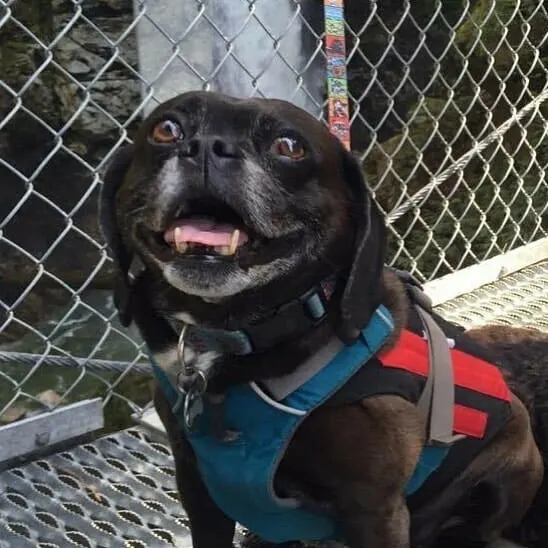As a member of the Etsy affiliate program and an Amazon Associate, I earn from qualifying purchases.
Is it just me or does anyone else always feel a bit of pressure in January to get their weight under control?
It seems like everyone and their dog is going on a diet or hitting the gym this time of year. It makes sense. Winter days are long and cold and in the winter, I reach for dog puzzle toys and bully sticks to keep my dogs entertained when it’s too rainy to play outside. Even our multiple walks get shortened as it gets too dark, too early, even if it isn’t raining cats and dogs. Luckily, it doesn’t take a whole lot to help your pooch slim down – it all starts with portion control.
An estimated 52% of dogs in America are overweight.
That means they eat more calories than they burn on a consistent basis. Most people don’t even realize that they are over feeding their dog. It’s really easy to do! As little as a one heaping tablespoon of extra kibble a day, can add as much as 50 calories, depending on what type of kibble you feed. The average 6″ bully stick, has around 88 calories. A large Milkbone has 115 (and I mean…ew.) A large Busy Bone has 445 calories. You guys, this is HUGE and maintaining a healthy weight is one of the kindest things you can do for your dog. So, how do you keep your pup on track?
5 Ways to Avoid Over Feeding Your Pudgy Pooch
- Measure Your Food
The best and easiest way to keep your pet on track is to actually measure their food using real measuring cups. Last year, a friend of mine had a kitty that was getting seriously chubby. Turns out, she was using an empty sour cream tub to measure her food. Kitty was getting almost DOUBLE what she should per day. Whoops! You can pick up a set of measuring cups for a $1. There is no reason NOT to properly measure your servings.
If you’re a raw feeder with an overweight pooch, invest in a food scale. It’s really easy to “eyeball” raw wrong and who really knows how much a turkey neck weighs anyway?
- Read the Labels
No two foods are created equally, so make sure you’re reading the bags to determine the correct serving size for your dog. For example, Kol would get 2 cups of one brand, 1 3/4 c. of another or 1 1/4 c. of another. It’s impossible to be sure you’re feeding the right amount unless you read the label. Find out how many calories are in a cup of your dog food, so you know how many calories your dog is supposed to be getting. You can usually find this info on the bag or the brand’s website. If you don’t see it there you can always call and if your brand can’t or wont tell you? Change brands. That’s shady as woof.
And REMEMBER: The servings on the bag are assuming their dog food will be your dog’s only source of nourishment, so if you supplement with fresh foods or give treats, you have to adjust the serving size.
- Buy Smaller Bowls I know this sounds crazy, but it works! You are more likely to over feed if you are serving a smaller amount of kibble in a bigger bowl. Buy bowls one size smaller than you usually do and it will look like you’re serving a lot more kibble. It makes it just a little bit easier to avoid over feeding.
- Monitor Dog Treats I’m not going to tell you to stop feeding treats because that’s crazy talk and Kol would cut me in my sleep if I tried it. You’re going to give your dog a few treats. The key is understanding what you’re giving and how it impacts the waistline. I found this chart from the Association for Pet Obesity Prevention wildly helpful. Treats should account for no more than 10% of your pet’s diet, so even one bone or chew in a week is usually too much. Try to make better treat choices.
- Stretch out your dog’s meals with veggies. Everyone suggests adding canned pumpkin, green beans or carrots to your dog’s kibble to cut calories, but I hear over and over how some people’s dogs don’t care for these veggies and just pick them out. At our house, we’ve had awesome success with veggies like acorn squash, cooked zucchini, broccoli, cauliflower, and spinach. I find that steaming and then pureeing them is the best way to trick fussy pups into eating them with their kibble.
With just a few simple changes, it can be really easy to help your pup slim down without “dieting”.
After all, no one likes a diet – even the dog! Have you ever helped your pet lose a few pounds? Do you have any wisdom to share?
 This is a blog hop! Every week, we invite you to link up your Tastiest Post and Hop On to discover all sorts of new treats recipes, great giveaways and more! To join in, grab the badge and add your link to this week’s hop!
This is a blog hop! Every week, we invite you to link up your Tastiest Post and Hop On to discover all sorts of new treats recipes, great giveaways and more! To join in, grab the badge and add your link to this week’s hop!
Powered by Linky Tools
Click here to enter your link and view this Linky Tools list…


J.B. Shepard, dog photographer
Wednesday 6th of March 2019
#3 is a great suggestions. Our Jack Russel, Lucky, does this fun thing where he doesn't think he's served enough food if he can see the bottom of the bowl. So, feeding him less was often a struggle as he would just whine nonstop. And, as anyone who has ever owned a Jack Russel will tell you, those little guys can be quite bossy.
They will not hesitate to reprimand you if they think you're screwing up. But with the smaller bowl, suddenly he doesn't see the bottom of the bowl when we measure his meals properly. Such a simple solution to a very yappy problem.
Sara @ BestPetReviews
Wednesday 19th of September 2018
Great tips! When my dog was alive, we gave her raw chicken. Some of the chicken pieces were different sizes so that helped to balance everything out for her. I especially like #5 because it is really important for dogs to get their veggies too!
Rachel
Tuesday 8th of May 2018
Tip #3 really work for me. Also spent time with your pup, go outside and do exercise will have a good result.
Rebecca
Monday 19th of March 2018
My pup loves nicking food from my kittens' bowls! He's a right food eater!
Mary Nielsen
Sunday 5th of February 2017
Meausring food is very important and especially if you are Raw feeding. May I also suggest that you should learn all of the basic calories numbers for the raw food you usually use, or write them down. But this is important to know.
Also another handy tip for introducing veggies to your dogs diet is to blend them in a blender. Some veggies like carots can be cooked and then blended into mash. And then you could add this into the kibble and mix it in. Your dog will have no choice but to eat it :)